AWM41 975 - [Nurses Narratives] Principal Matron Ellen Julia Gould - Part 1
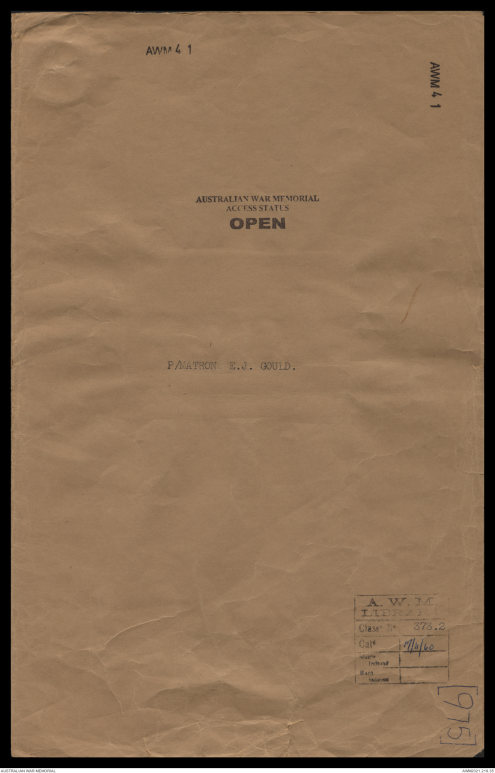
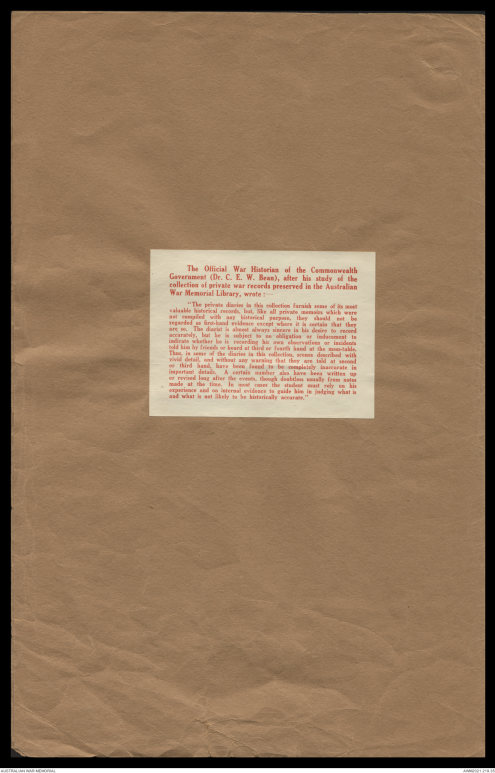

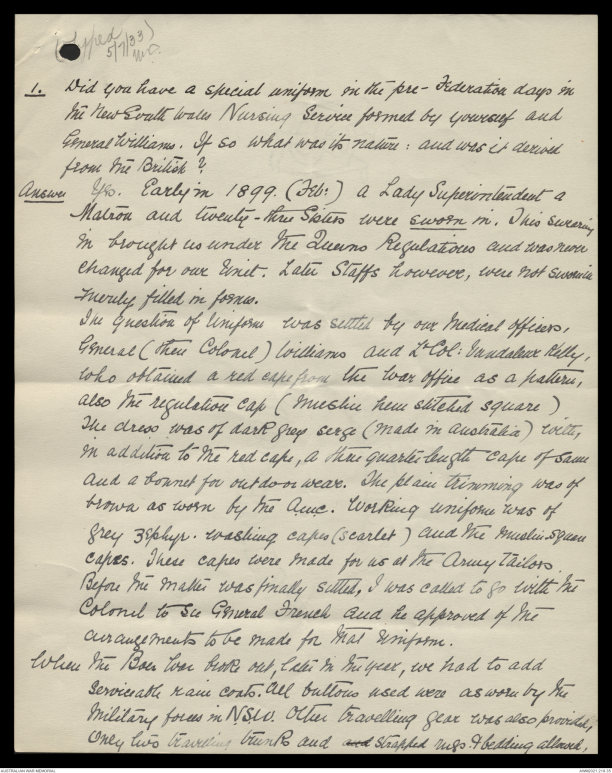
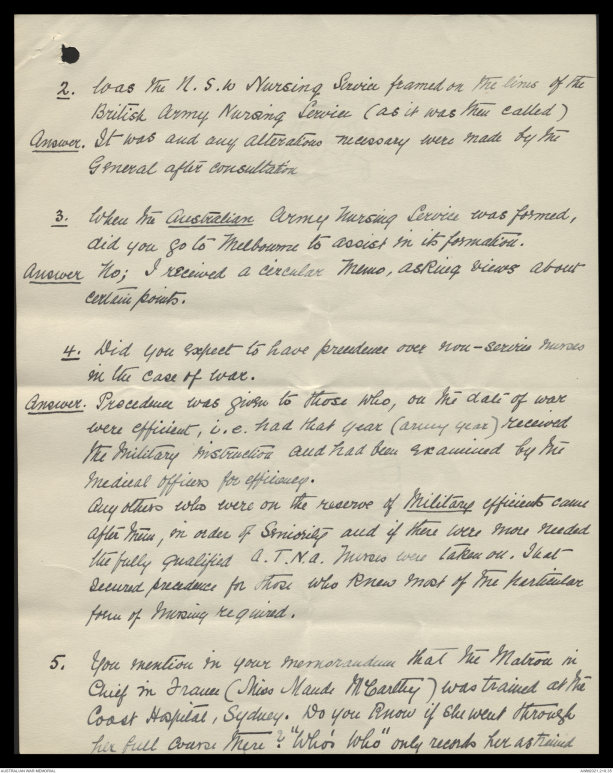
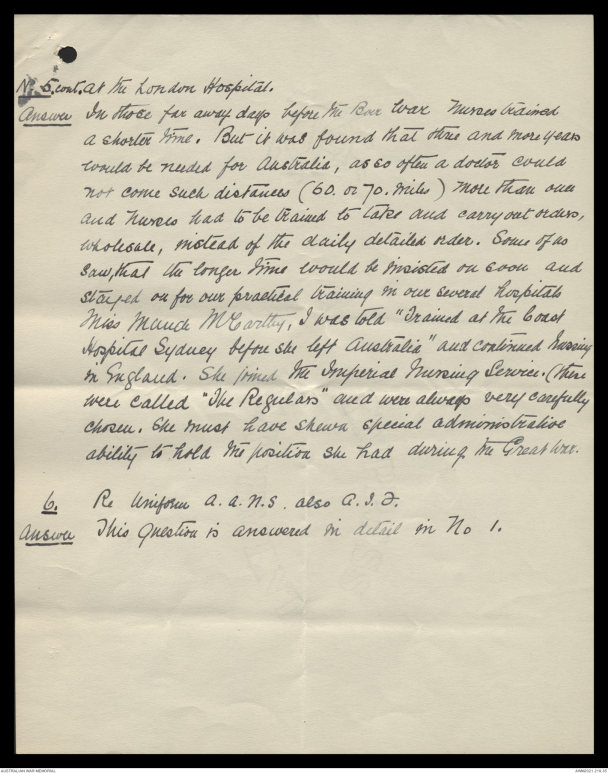
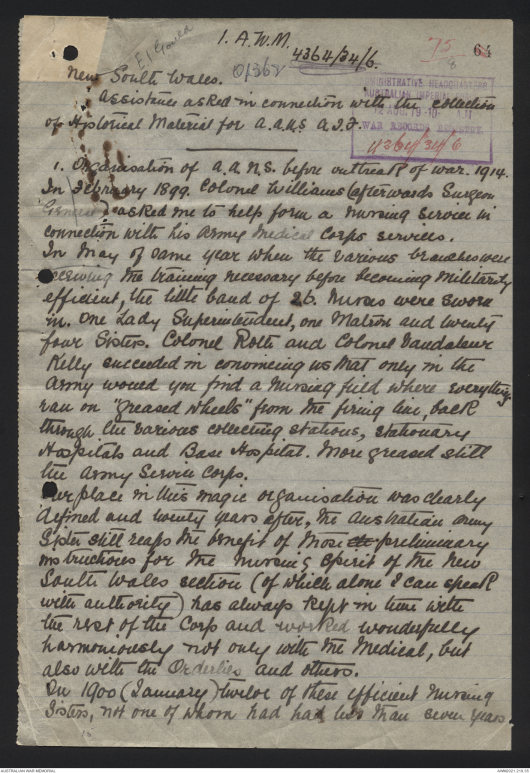


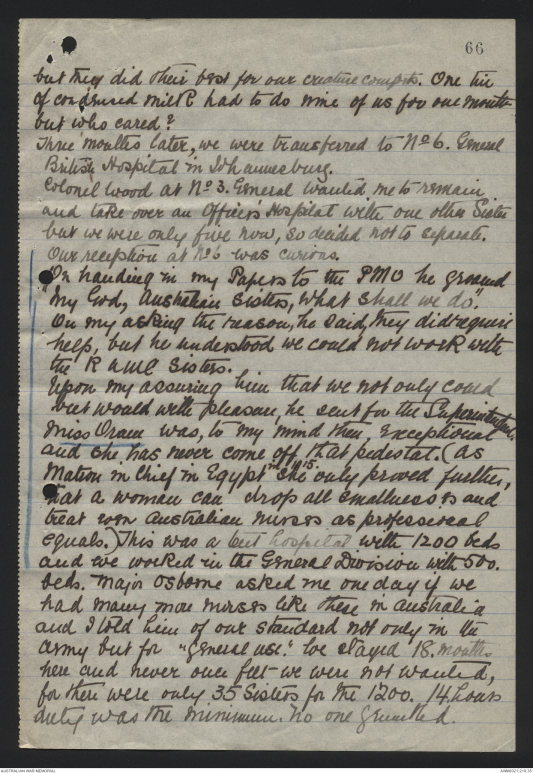
AWM 41
[*AWM 41*]
AUSTRALIAN WAR MEMORIAL
ACCESS STAUS
OPEN
P/MATRON E.J. GOULD.
A.W.M.
LIBRARY
Class No. 373.2
Cat. 17/6/60
[975]
The Official War Histories of the
Commonwealth Government (Dr. C. E. W. Bean), after his study of the
collection of private war records preserved in the Australian
War Memorial Library, wrote :-
"The private diaries in this collection furnish some of its most
valuable historical records, but like all private memoirs which were
not compiled with any historical purpose, they should not be
regarded as first-hand evidence except where it is certain that they
are so. The diarist is almost always sincere in his desire to record
accurately, but he is subject to no obligation or inducement to
indicate whether he is recording his own observation or incidents
told him by friends or heard at third or fourth hand heard at the mess table.
Thus, in some of the diaries in this collection, scenes described with
vivid detail, and without any warning that they are told at second
or third hand have been found to be completely inaccurate in
important details. A certain number have been written up
or reviewed long after the events, though doubtless usually from notes
made at the time. In most cases the student must rely on his
experience and on internal evidence to guide him in judging what is
and what is not likely to be historically accurate."
[*(Copy made 5/7/33)*]
Miss Ellen Gould
Nursing Chaplin
"Ghezireh"
Port Hacking Road,
Miranda.
29th June 1933.
Dear Colonel Butter,
With these answers to your questions, I am
sending along by registered post, one of my greatest treasures,
a book of the Boer War. Between pages 32.33 you will
find a group of Nursing Service, New South Wales Sisters
known as New South Wales Army Nursing Service Reserve,
formed in February 1899. This group includes five who
were attached to our Unit for Journey.
You here see the original uniform as described in my answer
to No. 1. question.
On our return from the Boer War, August 1902, we were
very soon merged into the A.A.N.S. and very little
Alteration was made in the uniforms until the war began.
The Lady Superintendent became a Principal Matron (Gould.)
There were two Matrons. (Julia Bligh Johnston and Miles Walker.)
Sisters and Staff Nurses made up the rest of the staff.
I am of course, speaking only of New South Wales No 2 District.
Until the Great War began, we remained on the Peace Basis
(26.efficients every May-June) and a number of Reserve
Sisters gradually brought up the numbers. If I can be of
any further assistance please say so. Time has treated me well
thank you. With kind regards
Yours faithfully
Ellen Gould.
(Typed 5/7/333) MD
1. Did you have a special uniform in the pre-Federation days in
the New South Wales Nursing Service formed by yourself and
General Williams. If so what was its nature : and was it derived
from the British?
Answer Yes. Early in 1899 (Feb:) A Lady Superintendent a
Matron and twenty-three Sisters were sworn in. This swearing
in brought us under the Queens Regulations and was never
changed for our Unit. Later Staffs however, were not sworn in
Merely filled in forms.
The question of Uniform was settled by our Medical Officers,
General (then Colonel) Williams and Lt Col. Vandeleur Kelly,
who obtained a red cape from the War office as a pattern,
also the regulation cap (Muslin hem stitched square)
The dress was of dark grey serge (Made in Australia) with,
in addition to the red cape, a three quarter length cape of same
and a bonnet for outdoor wear. The plain trimming was of
brown as worn by the A.M.C. Working uniform was of
grey zephyr. washing capes (scarlet) and the muslin square
capes. These capes were made for us at the Army tailors.
Before the matter was finally settled, I was called to go with the
Colonel to see General French and he approved of the
arrangements to be made for that Uniform.
When the Boer War broke out , later in the year, we had to add
serviceable rain coats. All buttons used were as worn by the
Military forces in N.S.W. Other travelling gear was also provided.
Only two travelling trunks and and strapped rugs & bedding allowed,
2. Was the N.S.W. Nursing Service framed on the lines of the
British Army Nursing Service (as it was then called)
Answer. It was and any alterations necessary were made by the
General after consultation.
3. When the Australian Army Nursing Service was formed,
did you go to Melbourne to assist in its formation.
Answer No; I received a circular Memo, asking views about
certain points.
4. Did you expect to have precedence over non-service Nurses
in the case of War.
Answer Precedence was given to those who, on the date of war
were efficient, ie. had that year (army year) received
the Military instruction and had been examined by the
Medical Officer for efficiency.
Any others who were on the reserve of Military efficients came
after them, in order of Seniority and if there were more needed
the fully qualified A.T.N.A. Nurses were taken on. That
secured precedence for those who knew most of the particular
form of Nursing required.
5. You mention in your memorandum that the Matron in
Chief in France (Miss Maude McCarthy) was trained at the
Coast Hospital, Sydney. Do you know if she went through
her full course there? "Who's Who" only records her as trained
No 5 cont. at the London Hospital.
Answer In those far away days before the Boer War Nurses trained
a shorter time. But it was found that three and more years
would be needed for Australia, as so often a doctor could
not come such distances (60. or 70. Miles) more than once
and Nurses had to be trained to take and carry out orders,
wholesale, instead of the daily detailed order. Some of us
saw, that the longer time would be insisted on soon and
stayed on for our practical training in our several hospitals
Miss Maude McCarthy, I was told "Trained at the Coast
Hospital Sydney before she left Australia "and continued Nursing
in England. She joined the Imperial Nursing Service (these
were called "The Regulars" and were always very carefully
chosen. She must have shown special administrative
ability to hold the position she had during the Great War.
6 Re Uniform A.A.N.S. also A.I.F.
Answer This question is answered in detail in No 1.
75/8 64
[*E.I Gould
I.A.W.M.
4364/34/6.
0/362*]
New South Wales.
Assistance asked in connection with the collection
of Historical Material for A.A.N.S. A.I.F
ADMINISTRATIVE HEADQUARTERS
AUSTRALIAN IMPERIAL FORCES
12 AUG 19-10 A.M.
WAR RECORDS REGISTRY
4364/34/6
______________________
1. Organisation of A.A.N.S. before outbreak of war. 1914.
In February 1899. Colonel Williams (afterwards Surgeon
General) asked me to help form a Nursing Service in
connection with his Army Medical Corps services.
In May of same year when the various branches were
receiving the training necessary before becoming Militarily
efficient, the little band of 26. Nurses were sworn
in. One Lady Superintendent, one Matron and twenty
four Sisters. Colonel Rolte and Colonel Vandeleur
Kelly succeeded in convincing us that only in the
Army would you find a Nursing field where everything
ran on "greased wheels" from the firing line, back
through the various collecting stations, stationary
Hospitals and Base Hospital. More greased still
the Army Service Corps.
Our place in this magic organisation was clearly
defined and twenty years after, the Australian Army
Sister still reaps the benefit of those de preliminary
instructions for the Nursing spirit of the New
South Wales section (of which alone I can speak
with authority) has always kept in time with
the rest of the Corp and worked wonderfully
harmoniously not only with the Medical, but
also with the Orderlies and others.
On 1900 (January) twelve of these efficient Nursing
Sisters, not one of whom had had less than seven years
reverse side of previous page
65
experience left Australia with the Second Contingent.
to the Boer War. On the "Moravian" we had crowded
quarters, but messed in the saloon comfortably. We
arrived at Cape Town on the day Kimberley was relieved
(Feb 19.1900) Twenty four hours after, 4 Sisters who had
been attached for voyage, were left to help at No 1. British
General Hospital. After a few days the rest disembarked
at East London where three more Sisters were left in
charge of Sister Bessie Pocock and the remainder commenced
duty at a Stationary Hospital at Sterkstroom near
Stormberg. Here we nursed those sick and wounded from
General Gatacre's Division around Stormberg. They
were mostly Irish troops and bonny loveable personalities
they were too. Here we met our first
Australian soldier who passed on. He was only with us
five days and during that time only noticed some roses
brought by a kindly clergyman from Queenstown. With
one of these in his hand he remarked that similar ones
grew at his home in St. Marys near Parramatta.
Under his pillow we found a little prayer book which
later I had the pleasure or returning to the donor, his
special Friend at home. Thirty one graves mark our
short stay of three months, after which the army having
got beyond Cronstadt in the Orange River Colony,
we left Sterkstroom and passing Bloemfontein full of
dead and dying at the time, went on to Cronstadt.
Here we nursed in connection with No 3. British General
at a large Dutch Church and were quartered in an old
corn store at night where rats scampered over us.
We boarded with a family who were not too loyal
66
but they did their best for our creature comforts. One tin
of condensed milk had to do nine of us for one month
but who cared?
Three months later, we were transferred to No6 General
British Hospital in Johannesburg.
Colonel Wood at No3 General wanted me to remain
and take over an Officers' Hospital with one other Sister
but we were only five now, so decided not to separate.
Our reception at No6 was curious.
On handing in my Papers to the PMO he groaned
"My God, Australian Sisters, What shall we do."
On my asking the reason, he said, they did require
help, but he understood we could not work with
the R AME Sisters.
Upon my assuring him that we not only could
but would with pleasure, he sent for the Superintendent
Miss Oram was, to my mind then exceptional
and she has never come off that pedestal. (As
Matron in Chief in Egypt in 1915 she only proved further,
that a women can drop all smallnesses and
treat even Australian Nurses as professional
equals.) This was a tent hospital with 1200 beds
and we worked in the General Division with 500.
beds. Major Osborne asked me one day if we
had many more nurses like these in Australia
and I told him of our standard not only in the
Army but for "general use". We stayed 18. months
here and never once felt we were not wanted,
for there were only 35 Sisters for the 1200. 14 hours
duty was the minimum. No one grumbled.
 Sam scott
Sam scottThis transcription item is now locked to you for editing. To release the lock either Save your changes or Cancel.
This lock will be automatically released after 60 minutes of inactivity.